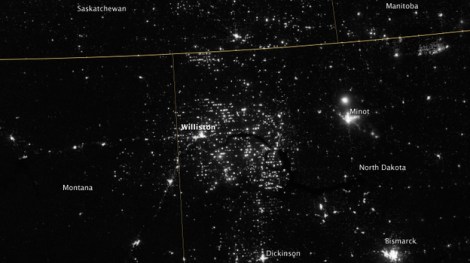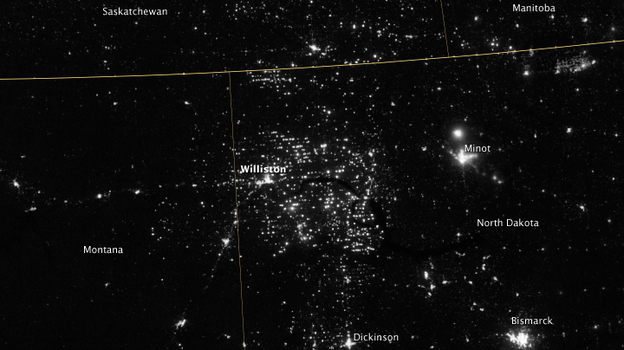Of all of the natural gas extracted in North Dakota over the past few years — so much that it has rewritten the state economy and overhauled electricity production across the country — only two-thirds has reached market. A full one-third of the gas sucked out of the ground never makes it off the drilling site and is instead burned on the spot, in gas flares now visible from space.

NASANorth Dakota’s pieces of flare are visible from space.
Yesterday, a bill aimed at curbing the practice died in the North Dakota state senate. From the Associated Press:
Sen. Tim Mathern’s measure would have cut an exemption commonly used by oil companies claiming an economic hardship of connecting a well to a natural gas pipeline. Oil companies in North Dakota can flare natural gas for a year without paying taxes or royalties on it. After that, companies can request an extension because of the difficulty of connecting the well to a natural gas pipeline. The exemption is nearly always granted by state regulators, who took no position on the legislation.
About one-third of North Dakota’s gas production has been burned off, or “flared,” since the oil boom began about five years ago. Less than 1 percent of natural gas is flared from oil fields nationwide, and less than 3 percent worldwide, according to the U.S. Energy Department’s Energy Information Administration.
Mathern’s argument is that the gas is a missed economic opportunity. Extractors could be selling the wasted gas, increasing supply and lowering prices for consumers. Oh, and the state could be collecting royalties on it, too.
Ending flaring could do inadvertent harm. What would happen if companies were forced to stop the practice or to pay royalties? Given fracking companies’ dodgy dumping practices in the state already, what’s to stop them from releasing an odorless, invisible gas directly into the air — where it contributes far more to global warming than carbon dioxide? Fracking is already the second-largest contributor to greenhouse gas emissions. That doesn’t need to go up.
There’s another lesson here. Fracking companies’ inability to connect wells to pipelines is another example of how the energy boom has outpaced the state’s infrastructure. It seems likely, though, that drillers will invest in more pipelines before they’ll invest in ancillary concerns like adequate health care.



